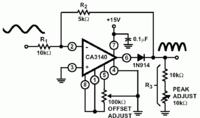bhl777
Full Member level 6
Hi All, I am reading one application notes from https://www.analog.com/library/analogDialogue/archives/44-04/absolute.pdf.
They use two op amps to realize absolute value circuit without using diode. But I have a question of its operating. Could someone give me some explanation of it?
Like this circuit

As the author decribed, when A pint has a negative input(for example, -5V), B point will be around 0V. Then A2 will be used to invert this negative voltage to positive.
I do not understand why when A node has a negative input, B node will be 0. It seems like A1 op amp does not work in this circumstances.
Could anyone advise? Thank you!
They use two op amps to realize absolute value circuit without using diode. But I have a question of its operating. Could someone give me some explanation of it?
Like this circuit

As the author decribed, when A pint has a negative input(for example, -5V), B point will be around 0V. Then A2 will be used to invert this negative voltage to positive.
I do not understand why when A node has a negative input, B node will be 0. It seems like A1 op amp does not work in this circumstances.
Could anyone advise? Thank you!
